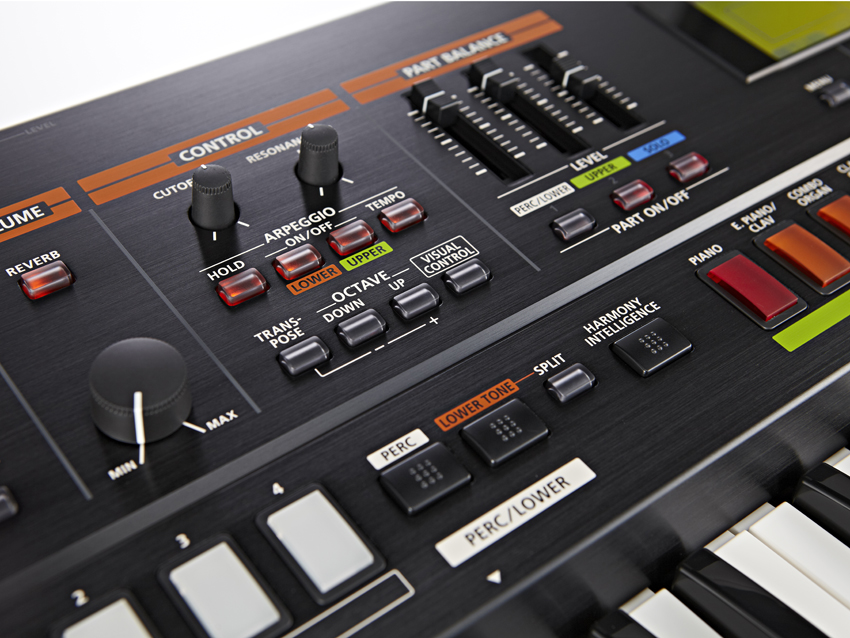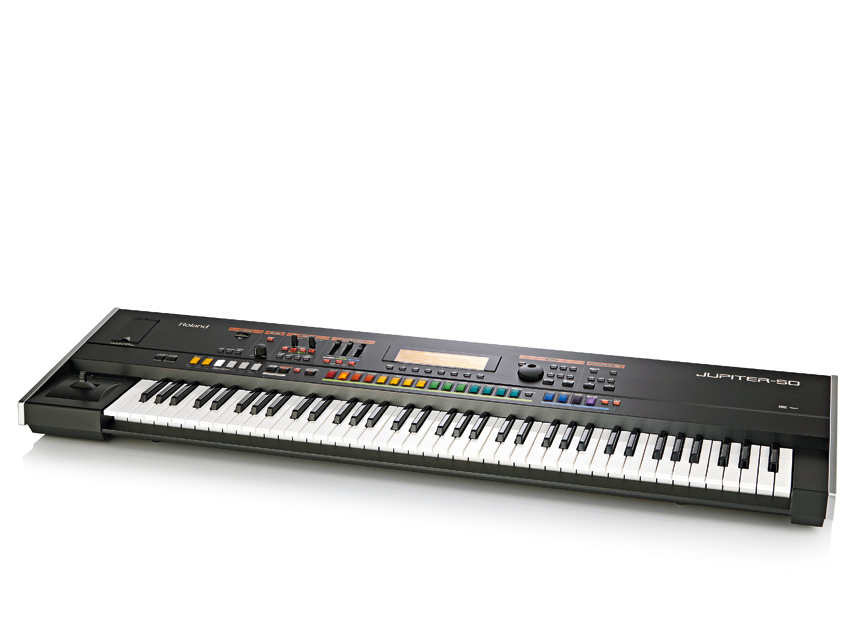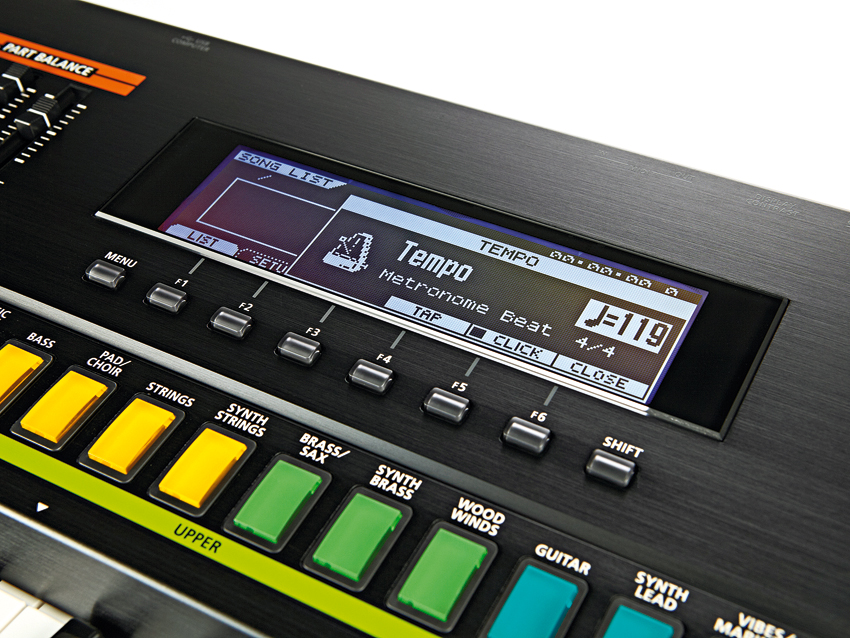MusicRadar Verdict
Cheaper and more portable than the '80 if you don't need its keybed, polyphony or touchscreen.
Pros
- +
Very portable; retains lots of the JP-80's functionality; sounds as good as the bigger JP-80.
Cons
- -
Suffers from the same interface issues - writ large - as its big brother; slightly less sturdy build.
MusicRadar's got your back

Roland Jupiter-50

Roland Jupiter-50

Roland Jupiter-50
It's not been long since we reviewed the Jupiter-80, concluding that in the main it sounded fantastic, though its bare bones, screen-centric interface let it down.
Well, since then Roland has been back in the lab and created the Jupiter-50, essentially a stripped down JP-80.
"Film composers should love the JP-80 for its breathtakingly realistic expressive acoustic sounds, while electronic producers will adore its extremely powerful synth section."
So are we in line for an improved screen and more hardware controls? Not so fast. The first thing you'll notice is that the JP-80's large colour touchscreen has been replaced with a smaller mono screen.
Given that the touchscreen in the JP-80 was the reason why Roland felt it was able to shirk realtime hardware knobs, the '50 is even worse off as - once again - this is one powerful synth with so much going on under the hood in the way of parameters that the screen can easily become overloaded with information. And now the lack of colour doesn't help.
There are only two assignable real-time dials, the S1 and S2 switch, three part sliders, the bender/mod stick and the D-Beam, which sounds a lot but in practice it could do with a lot more. Thankfully, the 'tone blender' function from the '80 is retained which facilitates multiple parameter control from the C1 or C2 dial.
Hands on
It's unclear why Roland has such an aversion to multiple real-time controllers, especially as the original Jupiters were so well adorned, but we hope it heads more in the direction of the slider-laden JD-800 (and even last year's excellent screenless SH-01 Gaia) in the future. This is what customers want and a lot of competitors, such as Nord and Korg, know that hands-on means extra sales.
By way of an antidote, Roland has an iPad app (downloadable from Apple's App Store) on the way, which will go a long way to making the JP-50 touchable. Clever? Certainly. Requiring the ownership of an iPad? You got it.
Want all the hottest music and gear news, reviews, deals, features and more, direct to your inbox? Sign up here.
Meanwhile back on the keyboard, the space where the real-time controllers should be is now the perfect place to place your 'Pad. And if you need to buy an iPad to get the most out of programming your '50 then the combined price is approaching that of the '80… Which - for a limited time - now comes with a free iPad 2… Still with us…? Let's just let it go, eh?
The '50 is markedly thinner than the bulky '80 with a keybed more like that on their excellent Juno Stage. Unfortunately that means that it's lacking the aftertouch of it's big brother, and while many other boards at this price are similarly strapped, the JP-50 really misses it, especially when you consider how expressive the Supernatural and behaviour-modelled sounds can be (and how much the feature was all over the complex sounds of the JP-80).
At least the 76-note keybed is almost indistinguishable in feel when put next to the JP-80 - it's super high quality and fast to play yet controllable. How about a weighted version of the JP-50 or '80 for those that want to get more out of the superb onboard pianos and EPs? Oh, and a 61-note cheaper version and rack module would be nice too!
Close to the tone
Out the back we lose the XLR balanced outs and the digital out of the '80 but the sub outs are retained along with USB, MIDI ports (no Thru) and stereo audio in. The two control pedal connections and sustain are still present and the switchgear feels largely the same quality as the JP-80, though the side panels are now silver-painted plastic rather than the much sturdier brushed metal panels on the '80.
One upside to this is that 7kg (almost 15lb) has been shaved off the weight of the JP-80, making this a very lightweight board - so much so that you can easily manage it yourself under one arm in a soft case, or in a lightweight plastic hard case.
Given that Roland sold the '80 as the perfect live 'board this is certainly a step in the right direction. Do watch out though if you have a small car as the JP-50 is actually a little bit longer than the JP80 at 1,268mm.
Sound it out
So what does it sound like? Let's quickly outline the sound structure - there's a bit of a learning curve here.
The main element in a JP-50 sound is a 'tone', which can be a 'Supernatural Acoustic' or a 'Supernatural Synth'. Up to four tones (acoustic or synth) can be layered to form a 'live set' (which includes envelopes, filters, offsets, panning and more) and one live set (two on the JP-80) can be used in what's called a 'registration'.
This registration contains a snapshot of performance-related settings such as splits, layers, note ranges, arpeggiator settings, pedal control assignments and more. It also includes an upper part, combined lower/percussion part and a solo part, each of which has a dedicated front panel volume slider and on/off switch, so that parts and layers can be quickly muted or faded in or out, which is great for live performance.
The dedicated coloured sound category buttons massively aid the sound selection process but we do miss the under-panel registration buttons on the JP-80 - though the '50 still has four on the main panel.
The JP-50's polyphony has been halved from 256 notes (on the JP-80) to 128 notes, which is still decent but perhaps a little restrictive, especially when you consider how much stacking power is available under the hood. As a result we noticed occasional note stealing in complex multi-layered patches, though for the majority of sounds it's not a problem.
Also, there are now three parts per registration (Perc/Lower, Upper and Solo) compared to the four parts on the JP-80. This isn't such a big deal in practice but bear in mind it means less complex splits and layers.
A very handy feature that's debuted on the JP-50 (and that's made its way to the JP-80 with the free Version 2 software) is the manual/single play mode, which immediately switches the JP-50 to a single upper part, from which you can quickly build new sounds. This really simplifies programming a lot.
Unfortunately, the drawbar organ still doesn't have a dedicated B3-style chorus (as noted in our JP-80 review) and though drawbars appear on the screen now you can't touch and drag them…
We can't really quibble with any of the sounds that the JP-50 can produce and the new serial effects routing mode helps open up more sonic possibilities. However, be aware that there are only four effects units, compared to the JP80's eight, plus no dedicated solo/percussion part effects and no mastering effects either. That said they do sound great and are very tweakable.
50-50
Interface gripes aside, the JP-50's real appeal is as a workhorse studio instrument that can cover all of your staple sounds admirably (particularly if you're a Sonar user - the JP-50 becomes a perfect front end for the included Sonar LE software). Film composers should love it for its breathtakingly realistic expressive acoustic sounds, while electronic producers will adore its extremely powerful synth section, particularly with the new analogue modelled filter types on board.
One of the smartest things Roland has done is keeping the great-sounding D/A converters found in the JP-80 and so the '50 sounds every bit as wide, smooth and punchy. It's easily one of the best sounding synths available.
This is a very important point, because the sound quality is one of the most redeeming features of the new Jupiter series and it kind of makes up for the bare interface.
For live performers the iPad editor puts back the missing controls, screen and more, and if you can live without aftertouch and the halved polyphony then definitely consider the JP-50 based for sound quality, scope and portability. Shame the '50 couldn't be cheaper but then we wish that about everything!
Need the extra notes, keys and screen? Go for the '80. But if you need to save a little money and weight, then it's the '50.